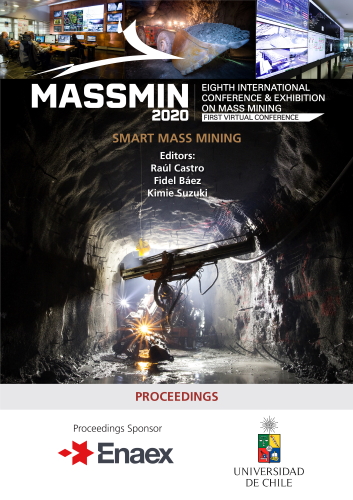Structural recognition and rock mass characterization in underground mines: A UAV and LiDAR map ping bas ed appr oach

|
Authors: Canales, CC; Sellers, ES |
This paper is hosted with the kind permission of Lulea University of Technology, International Conference & Exhibition on Mass Mining, 2024.
DOI https://doi.org/10.36487/ACG_repo/2063_97
Cite As:
Canales, CC & Sellers, ES 2020, 'Structural recognition and rock mass characterization in underground mines: A UAV and LiDAR map ping bas ed appr oach', in R Castro, F Báez & K Suzuki (eds), MassMin 2020: Proceedings of the Eighth International Conference & Exhibition on Mass Mining, University of Chile, Santiago, pp. 1302-1312, https://doi.org/10.36487/ACG_repo/2063_97
Abstract:
The current geotechnical challenges in underground mines create the necessity for tools that can make safe and quick geological and geotechnical assessments, especially in hazard zones such as open stopes, in environments that are increasingly deep and confined. The purpose of this work was to test and validate the use of a new technology called Hovermap (HM). This tool combines the autonomous management of a drone (UAV) with the ability to generate 3D surface representations using LiDAR. This research shows the results of two case studies. The first case study is a comparison of data collected with Hovermap of a medium-quality scan with traditional methods such as Cavity Monitoring Surveys (CMS) and Core Logging to assess surface quality representation for geotechnical purposes. The results showed discordance between the RQD calculated with HM data and RQD calculated with traditional methods. Nevertheless, the origin of the problem is clear, and the solutions are also displayed. Once these results were validated, a second case study was performed with a higher quality scan and easier structural visualization for structural identification. The results were analysed to estimate the potential for use in underground mines for stability analysis. Furthermore, a series of drone flight parameters were estimated to perform scans depending on different purposes, such as velocity and wall distance and Sample Effort Variable (SEV).
References:
Benton, DJ, Seymour, JB, Boltz, MS, Raffaldi, MJ & Finley, SA 2017, ‘Photogrammetry in underground mining ground control — Lucky Friday mine case study’, in J Wesseloo (ed.), Proceedings of the Eighth International Conference on Deep and High Stress Mining, Australian Centre for Geomechanics, Perth, pp. 587-598.
Bolkas, D, Vazaios, I, Peidou, A & Vlachopoulos, N 2018, ‘Detection of Rock Discontinuity Traces Using Terrestrial LiDAR Data and Space-Frequency Transforms’. Geotechnical and Geological Engineering, vol.36, no. 3, pp. 1745-1765.
Cacciari, PP & Futai, MM 2016, ‘Mapping and characterization of rock discontinuities in a tunnel using 3D terrestrial laser scanning ‘. Bulletin of Engineering Geology and the Environment, vol. 75, no. 1, pp. 223-237.
Goodman, RE 1989. Introduction to rock mechanics, vol. 2, Wiley New York.
Lato, M, Kemeny, J, Harrap, RM & Bevan, G 2013, ‘Rock bench: Establishing a common repository and standards for assessing rockmass characteristics using LiDAR and photogrammetry’. Computers & Geosciences, vol. 50, pp.106-114.
Lato, MJ, Diederichs, MS & Hutchinson, DJ 2010, ‘Bias Correction for View-limited Lidar Scanning of Rock Outcrops for Structural Characterization’. Rock Mechanics and Rock Engineering, vol. 43, no. 5, pp. 615-628.
Lato, M 2010, ‘Geotechnical applications of LiDAR pertaining to geomechanical evaluation and hazard identification’, Thesis (PhD, Geological Sciences & Geological Engineering. Queen´s University.
Riquelme, AJ, Abellán, A, Tomás, R & Jaboyedoff, M 2014. ‘A new approach for semi-automatic rock mass joints recognition from 3D point clouds’. Computers & Geosciences, vol. 68, pp. 38-52.
Rogers, SF, Bewick, RP, Brzovic, A & Gaudreau, D 2017, ‘Integrating photogrammetry and discrete fracture network modelling for improved conditional simulation of underground wedge stability’, in J Wesseloo (ed.), Proceedings of the Eighth International Conference on Deep and High Stress Mining, Australian Centre for Geomechanics, Perth, pp. 599-610.
Slob, S, Hack, HRGK, Feng, Q, Röshoff, K & Turner, AK 2007, ‘Fracture mapping using 3D laser scanning techniques’. in LR e Sousa & CON Grossmann (eds), 11th congress of the International Society for Rock Mechanics : the second half century of rock mechanics, 9-13 July, 2007, Lisbon, Portugal. Taylor & Francis / Balkema, Leiden, The Netherlands, pp. 299-302.
Villaescusa, E 2014, ‘Geotechnical design for sublevel open stoping’, CRC Press.
© Copyright 2025, Australian Centre for Geomechanics (ACG), The University of Western Australia. All rights reserved.
View copyright/legal information
Please direct any queries or error reports to repository-acg@uwa.edu.au
View copyright/legal information
Please direct any queries or error reports to repository-acg@uwa.edu.au
